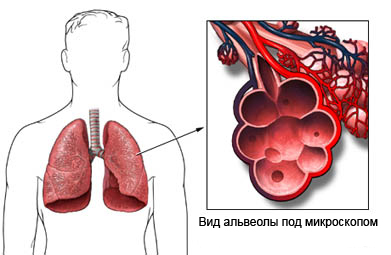Allergic bronchopulmonary aspergillosis – ABLA
Description of allergic bronchopulmonary aspergillosis
Allergic bronchopulmonary aspergillosis (ABLA) It is an allergic lung disorder. The disease is caused by the fungus Aspergillus fumigatus (OF). Aspergillosis can occur in the form of:
- Pulmonary infections, which can spread to other parts of the body (more common in patients with suppressed immune system);
- Gribkov (aspergillomas) lung, after suffering a lung disease or infection.
Causes of allergic bronchopulmonary aspergillosis
ABPA is caused by an allergic reaction to inhaled AF disputes. AF is a fungus. It is found in decaying vegetation, soil, some foods, dust and water. The allergic reaction worsens people, asthma or cystic fibrosis. Inhaled AF live on mucus in the lungs, calling:
- Сенсибилизацию к OF;
- Recurring allergic inflammation of the lungs;
- Blockage of alveoli (the tiny air sacs in the lungs) eozinofilami (a type of white blood cells, participating in some allergic reactions).

Risk factors for allergic bronchopulmonary aspergillosis
Factors, which increases the risk of ABPA:
- Asthma;
- Mukovystsydoz;
- Tuberculosis;
- Sarkoidoz.
Simptomы ABLA
Symptoms of ABPA are usually the same, like progressive asthma. These include:
- Breathlessness;
- Hripota;
- Weakness, malaise;
- Unintentional weight loss;
- Chest pain.
As ABPA progresses, other symptoms may occur , including:
- Abundant, brownish allocation, and / or bloody sputum;
- Low-grade fever (increase in body temperature to 37-38 ° C)
In severe cases, ABPA can cause:
- Bronchiectasis – Extension of the bronchi, usually, caused by inflammation;
- Scarring in the lungs.
Diagnosis of allergic bronchopulmonary aspergillosis
The doctor asks about the symptoms and medical history, and performs a physical exam. Tests may include:
- Chest X-ray – to take a picture of lungs;
- Sputum analysis – check sputum for:
- Detection AF;
- Definitions high level of eosinophils;
- Blood tests to detect:
- High levels of eosinophils;
- Antibodies showing allergic reaction to AF;
- Test to check for allergic sensitivity by placing small amounts of AF in the skin;
- Biopsy of lung or sinus tissue;
- Pulmonary function tests (PFTS) – It is used to monitor breathing and determining the capacity of the lungs.
ABPA can appear quite similar to non-ABPA induced asthma, and often difficult to determine, to what extent ABPA is contributing to the symptoms. Thus, ABLA, usually, diagnosed after several tests.
Treatment of allergic bronchopulmonary aspergillosis
The goals of treatment include:
- Suppressing the allergic reaction to AF;
- Decreasing lung inflammation;
- Prevention of colonization in the lung AF.
ABPA is usually treated with:
- Prednisolone (oral corticosteroid medication);
- Antifungal agent.
Prevention of allergic bronchopulmonary aspergillosis
Avoid contact with the AF best way to prevent ABPA. But, it's difficult, AF because much distributed in the environment. Guidelines for preventing contact with AF include:
- Avoid places with:
- Decaying plant;
- Constant high humidity;
- Regular house cleaning.
Measures, to avoid symptoms and prevent permanent lung damage caused by ABPA, They include:
- Ongoing testing and monitoring of ABPA;
- Early treatment of diseases.
